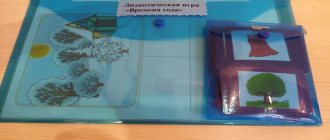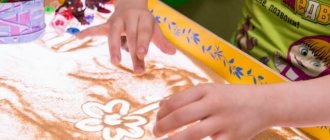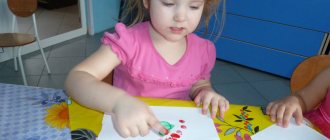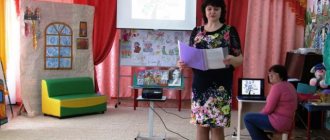The importance of didactic material in kindergarten
Didactic manuals serve as the basis for speech development classes. They create a storyline for the lesson, involving children in the game plot. This takes into account the concreteness and figurativeness of children's thinking. With their help, a fascinating game situation is created for the child to learn, where he is passionate and motivated to complete tasks.
The development of children's speech relies heavily on various didactic aids. Their diversity and the ability to make most of them with your own hands allows you to choose a suitable option for conducting classes with children.
Didactics - the science of learning
A good way out of the situation is educational games. Psychologists and teachers established back in the middle of the last century that the skills and knowledge gained through an exciting game are most firmly and sustainably acquired.
In addition, it is easier to persuade a child to repeat the same game than to repeat the same lessons. And repetition, as we know, is the mother of learning.
Such educational games are called didactic. Didactics is a science that studies the cognitive and teaching process itself.
Read here - How to make a drilling machine with your own hands: making a desktop homemade machine. Step-by-step description of the construction of the device (95 photos + video)
The fascinating process of creating your future favorite toy is also a kind of useful educational game. All that remains is to decide which skills to develop first.
Didactic games on sound culture of speech in the senior group
Didactic games for the development of sound culture can be carried out not only in special classes. During morning exercises, you can do articulation exercises, play ball with the children during a walk, encouraging them to pronounce words clearly. Didactic games with cards, puzzles, pictures, and writing lines for hand development can captivate a child in the evening hours.
Goals of the ZKR games
Exercises to develop speech sound culture are games in which rules must be followed. They are created with the sole purpose of developing the speech of a preschooler.
Systematic implementation of didactic games will help the child:
- remember new words;
- learn to speak coherently;
- catch the difference between words that sound similar;
- learn about word forms, word connections in phrases;
- learn to speak with different intonations;
- make statements, participate in dialogue.
Note! During a didactic lesson, the child becomes interested and remembers better.
Learning to select words with a given sound
By the age of 6, a child is able to determine what sounds are in words and independently select certain words. To continue the development of phonemic hearing, children are offered games and exercises in which they need to find given sounds. A set of games for the formation of sound culture in the older group could be as follows:
- "Catch the sound!" — stop the speaker by clapping his hands if he hears a word with a given sound.
- a preschooler is interested in naming words that begin with a certain sound; you can complicate the task: “Name something that starts with “A” and ends with “Z”;
We are interested in everything
- it is asked to remember words whose last sound is the same as in the word “cheese”;
- correct pronunciation errors;
- a child architect will draw a letter in the air and form it out of sticks; a soloist will sing the letter.
Important! Teach your child through play so that he doesn’t lose interest. to systematic training.
Sound analysis training
When learning to write and read, the initial process is sound analysis, the ability to correctly determine the number of sounds in a word, give a phonetic description of each sound, and indicate the location of each sound.
Important! The child must be able to divide a word into sounds, establish their quantity and sequence, which will help him in mastering literacy.
Using the fairy tale format for the development of speech in preschoolers
Difficulties with sound analysis are observed in children with problems in speech development. The baby cannot consistently reproduce sounds in words. He focuses only on the meaning of the word. For example, an adult asks to name the sounds in the word “juice,” and a child says “raspberry, apricot.” If a child is given a set of letters and asked to read words, he will not be able to do this, so teaching phonics is important, otherwise the child will not learn to write.
Working on diction
A preschooler must have good diction. This skill develops gradually as the articulatory apparatus develops.
Note! The child must be able to clearly pronounce every sound, word and sentence.
Children cannot control their speech independently, so they pronounce the endings of words unclearly and miss words. In the electronic catalog you can find examples of various exercises:
- "Egorki"
Pronunciation of the tongue twister “Like on a hill, on a hillock there are thirty-three Yegorki” while inhaling and exhaling. The child must say the entire phrase and use the entire supply of air collected. if the air remains, then you need to teach the preschooler how to properly distribute his breathing.
- "Polite bow"
- Children rise on their toes, take a breath, spreading their arms to the sides. Bend over, gradually folding your arms - exhale.
With systematic exercises, the child develops speech breathing, articulation, and improves diction.
Preschooler's notebook
Learning to form new words from the original ones
The child receives initial information about how words are formed in a language in kindergarten. During word formation exercises, the preschooler develops interest in the spoken word, and a desire arises to say correctly: “I built the word the way others say it.”
Examples on how to form a new word, but also on little-known words.
Note! In order for a preschooler to correctly select word-forming morphemes, it is necessary to teach him to perform semantic analysis. You can use didactic exercises (answer a question, choose a paired word) or emotional exercises (come up with your “own” words).
It is necessary to point out to children the mistakes in education (“fighter”, “chatterbox”). Verbal exercises aimed at differentiating masculine and feminine suffixes are presented below:
- Who has what kind of mother?
- We are athletes: Children complete the sentences: skiing - skier, jumping - jumper. The themes “Who will I be”, “Who serves in the army” are similarly explored;
- Name the car in one word";
- Find one word instead of two.
Where are teaching materials used?
The use of hand-made speech development aids for preschoolers creates a playful basis for working with them and determines the storyline of the lesson. A child, especially in the junior and middle groups of kindergarten, thinks concretely, using images, rather than abstract logical constructs. He can react to assignments received from a speech therapist or teacher, being a participant in a specific, albeit fictitious, situation. The teaching aids serve as the factual basis for their learning each year.
Speech development based on visual cues
When a child learns to express his thoughts, he must follow a certain pattern of expressing his thoughts. For a child who is almost unable to concentrate on one subject at his age, this is impossible. Using teaching aids in the form of cue cards helps build a story line. For younger children, we are talking about much simpler things. They simply have to name the objects or briefly describe the actions with the cue cards.
Speech therapist works with a child
For example, in the didactic manual “Zippers,” the child must choose among the open colored zippers lying on the table those that correspond to the teacher’s instructions and close them. At the same time, the child describes his choice, its reasons and the actions he takes.
At an older age, each visual cue can be used together with leading questions from the teacher and be the basis for a coherent story. This can be seen, for example, in classes devoted to professions.
Lesson on speech development in the senior group of kindergarten
Every description of your actions, answer to a specific question, or short story based on visual cues helps your child better develop his speech skills. Serve as preparatory exercises for adult life.
Learning to retell
The development of coherent speech in children is one of the most important skills that a child must be taught. Without mastering it, he will not only not be able to develop properly intellectually, but also will not be able to fully socialize, not being able to conduct a dialogue or express his thoughts.
When retelling, the child must create a coherent, long story. However, for this he will need tips, which can be received during didactic games and from the teacher.
The development of fine motor skills plays an important role in this process.
Important! By engaging in retelling, you will be able to strengthen your speech and intellectual skills and increase the level of development of your personality.
Learning to think
Human speech is closely related to thinking. The same is true for a child. Communication is not limited to expressing your thoughts or describing actions. The level of speech proficiency is largely determined by the degree of development of the child’s personality and thinking.
Do-it-yourself teaching aids for kindergarten can be used not only for stories, but also as an excuse to ask your child questions about cause-and-effect relationships in the world around him. For example, using cards related to the plots of fairy tales, you can ask questions about the circumstances of the characters’ actions, the reasons and consequences of their actions.
You can combine the classes in question with the study of mathematics.
In addition, the educational function of speech development classes is important. For example, if a child is asked questions about the features and beneficial properties of the plants depicted in the pictures, then gradually this knowledge will be consolidated in the child. If additional questions are asked about this material, the child’s knowledge will become more detailed and practical.
Preparing for literacy
To do this, you need to learn not only oral speech, but also study letters and words. Children of senior preschool age, with the help of a teacher and parents, are able to master the alphabet and basic reading skills.
For this purpose, a do-it-yourself didactic manual on speech development for kindergarten with cards depicting letters, syllables or words can be used.
Picture 4 Speech corner





